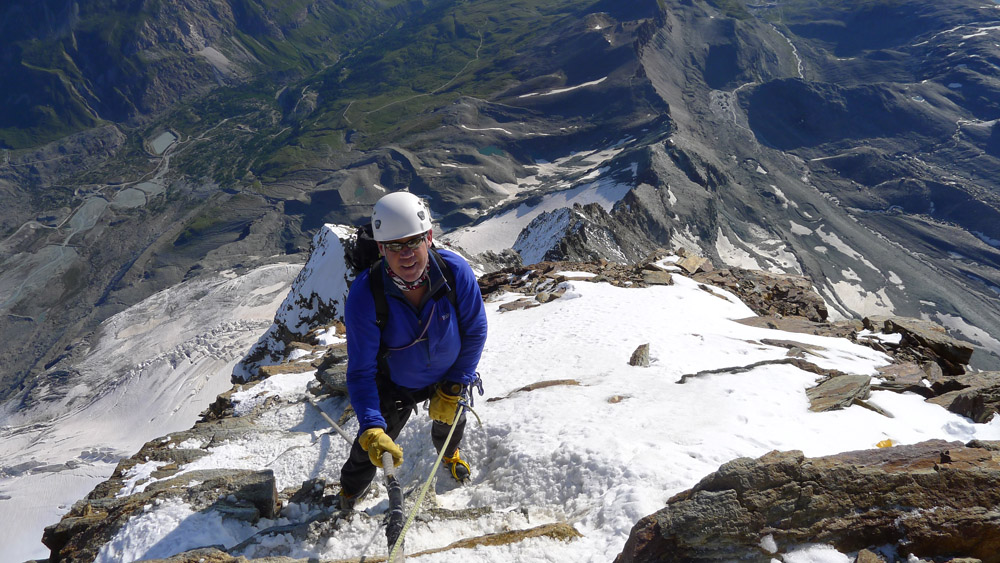So you want to climb the Matterhorn? IFMGA Mountain Guide James Thacker explains exactly what you can expect when climbing the route of the first ascent, the Hörnli Ridge…
Whether you are a young alpine tiger or are starting your mountaineering career in your 40’s, the Matterhorn is almost sure to be on your ticklist. To climb this famous summit remains a significant challenge and is still one of the European Alps most sought-after ascents. It is a true ‘mountaineer’s summit’, and any ascent will require experience, training and practice, with its technical difficulty alone making it stand head and shoulders above Mont Blanc.
The Matterhorn, Monte Cervino (in Italian) or Mont Cervin (in French) lies between the town of Zermatt in Switzerland and Breuil-Cervinia in the Italian Aosta Valley to the south. At 4,478m the summit is high – in fact, one of the highest summits in the Alps – with no truly ‘easy’ route to the top. The Matterhorn represents much more than its surveyed height however, forming an iconic symbol of Switzerland and the Valais region in particular. The constituent faces and ridges are steeped in history, triumph and tragedy as well as loose rock.
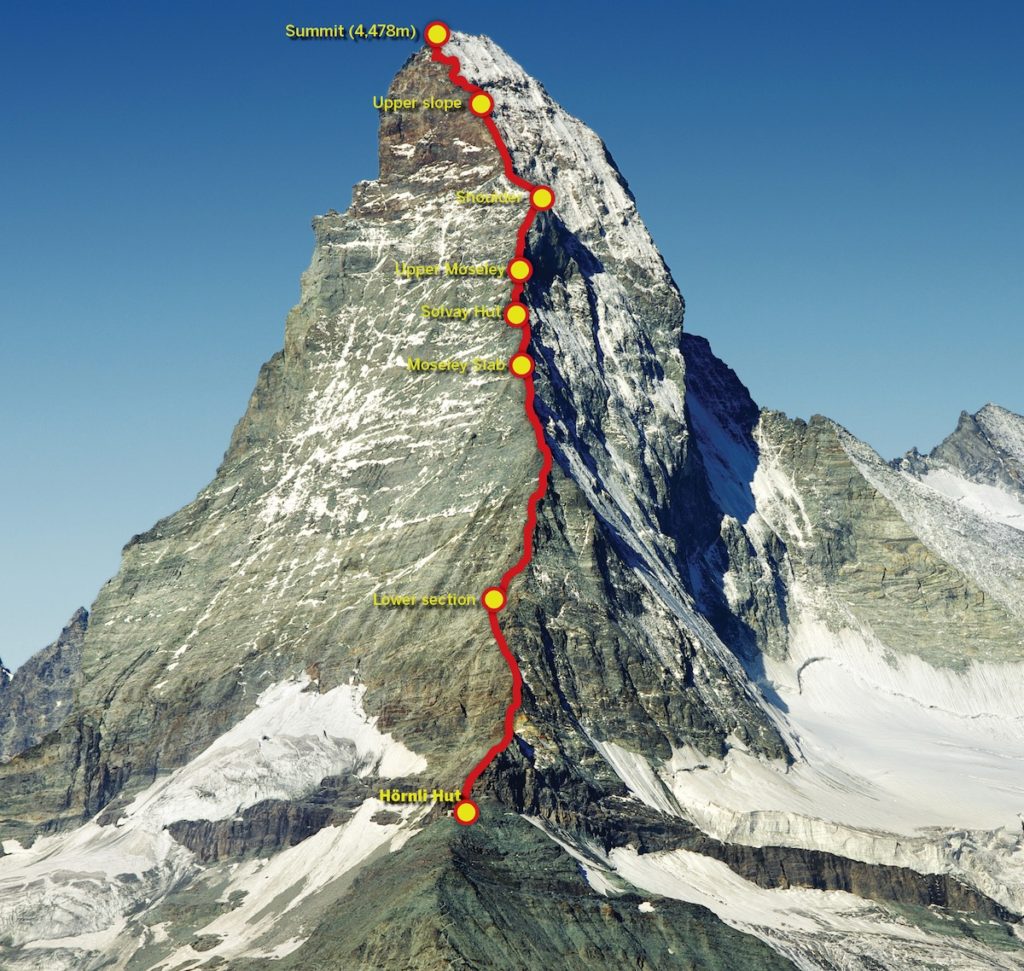
Hornli Ridge: the route of the first ascent by Edward Whymper in 1865
Hörnligrat
To climb the Matterhorn by the easiest ridge – the Hörnli Ridge (or Hörnligrat) – one needs the ability to cope with roped scrambling for a long period of time. As a Guide, I personally think of the Matterhorn as a unique challenge, the overall itinerary being a much greater undertaking than its constituent parts. The overall commitment of the route is clear when you consider that you need to ascend and descend a vertical interval of 1,220m from the Hörnlihutte in a timely and expedient fashion.
The most common method of ascent starts in the town of Zermatt, from which you take the cable car to Schwarzsee before walking to the Hörnlihutte at 3,260m (recently renovated in 2014 and opening this summer). Starting at about 4am, most of the lower section is climbed in darkness before reaching the summit early, then descending before the build up of afternoon cloud.
Athletic rock climbing ability is not really required – instead, sure-footedness, good balance and the ability to deal with the heady exposure of such a significant summit are more useful for a successful ascent. Small pitches, or rope lengths of climbing, are involved throughout the route’s length, while slick ‘moving together’ on the rope with you partner (or Guide) is imperative to ensure a timely ascent, since the summit is also very exposed to any deterioration in the weather.
The route is graded ‘Assez Difficile’ (AD) and a quick glance at the Alpine Club Guidebook (details at bottom of page) will tell you that the route includes sections of UIAA III climbing – which is around British Difficult or Very Difficult standard. By modern standards such grades are relatively easy, but when you consider the length of the difficulties and the fact that you will be climbing in mountaineering boots rather than precision rock shoes, the challenge starts to look considerable. On top of that you need to contend with a pre-dawn start, intricate route finding in the dark and, in descent, sustained scrambling, loose rock, snow, ice, fixed ropes – not to mention down climbing and abseiling – so a wide range of skills are a prerequisite for any prospective Hörnli Ridge climber.
A mountain of such scale inevitably comes with some objective hazards too, and it’s wise to anticipate these before embarking on an ascent. The good news is that as a predominately rock ascent – with just the final section on snow and ice – this is one place where you don’t need to worry about seracs and crevasses. However, rockfall can be a considerable problem if you stray from the best possible line, or other parties do so above you.
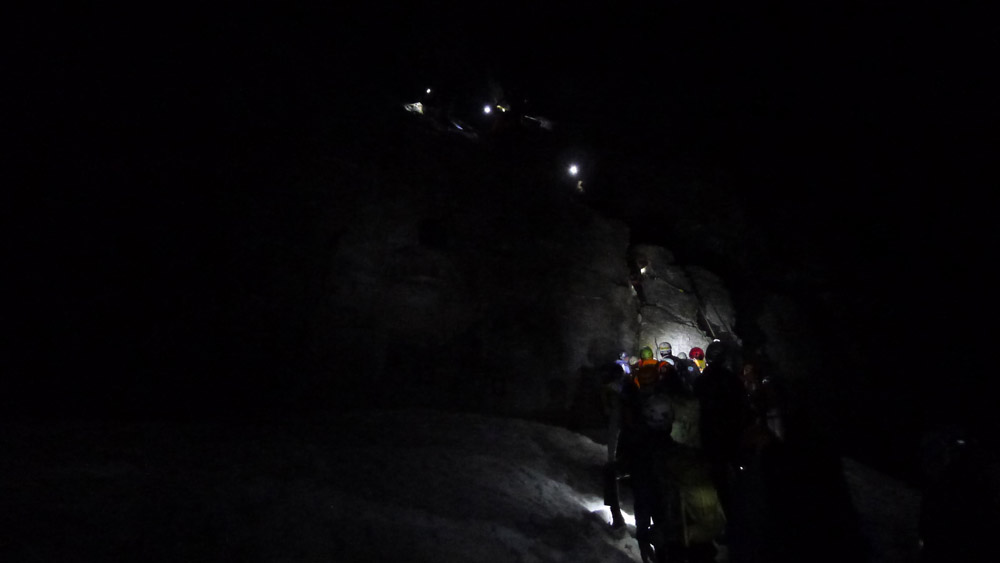
An early start means some intricate route-finding has to be negotiated in the dark
Route-finding is really important to ensure that you stay on well-travelled rock. A moment’s inattention can see you in a dead end, so it’s important to stay sharp and take a bush tracking-type approach, keeping an eye out for footprints, worn rock and crampon scratches. This is especially important on the lower section of the mountain where the route actually takes the flanks, rather than being on or close to the ridge crest. Any slight errors or a momentary lapse in concentration here will lead onto the loose stuff, and as one of my colleagues once so eloquently described it “the Matterhorn is just steep enough to stack choss”.
The scale of the Hörnligrat also brings the challenge of speed and efficiency. Such an exposed summit, isolated as it is on the Swiss-Italian frontier attracts bad weather quickly. Even in relatively stable conditions the summit can be shrouded in cloud as moist air rises from the Italian plains up the Aosta Valley. The sustained terrain on the Matterhorn may feel comfortable enough in dry conditions but being caught in a storm high on the mountain is not one to savour. Wet rock, verglass or snow will augment the difficulty considerably, especially in descent. Sadly, the Matterhorn is also one of the most dangerous summits in the Alps with a rumoured 500+ deaths since its first ascent.
Experienced required
The obvious question for anyone considering climbing the Hörnli Ridge is: what experience do you need to make an ascent? The answer is perhaps obvious; most mountaineers will need to prepare well in advance and do some long-term planning in preparation for an ascent. Sadly, 1,220m on a step machine in the gym is simply not going to cut it, and time in the mountains will be well spent. There are very real barriers to achieving those big days in the mountains, but a good way of maximising time is to concentrate on scrambling terrain with increasing vertical intervals. Snowdonia, the Highlands and North West Highlands, and the Isle of Skye all offer fantastic scrambling terrain on which to practise. This all helps overall fitness but also contributes to developing balance, agility and co-ordination on scrambling terrain and that feeling of being ‘good on your feet’. This, combined with some training ascents of other 4,000m peaks and nights spent sleeping at around 3,000m will be essential for acclimatisation. Sadly, no shortcuts exist and this isn’t a challenge which can be achieved by following a closely-defined checklist, but that’s the ultimate attraction – the Matterhorn is definitely no ‘quick tick’.
At 4,477m the Matterhorn is well over the magical 4000m mark and, combined with such a rapid ascent and descent on rock, people often suffer from altitude illness as they work hard on the ascent, in contrast to the slow plod of Mont Blanc. Preparation is key and it may be that you need to take longer than a week for successful acclimatisation.
The peak season for climbing the Matterhorn is generally from mid July to late August. Normally the Hörnligrat needs to be largely clear of snow on the lower section and ideally up to The Shoulder, close to where the upper fixed ropes begin. The Matterhorn Webcam is a useful tool if planning a visit; the mountain should really appear pretty much clear of snow when viewed from Zermatt to be considered in optimum condition. Inevitably, this period also coincides with the high season in the Alps when the mountains are at their busiest, the conditions are often dry and the risk of rockfall is ever- present.
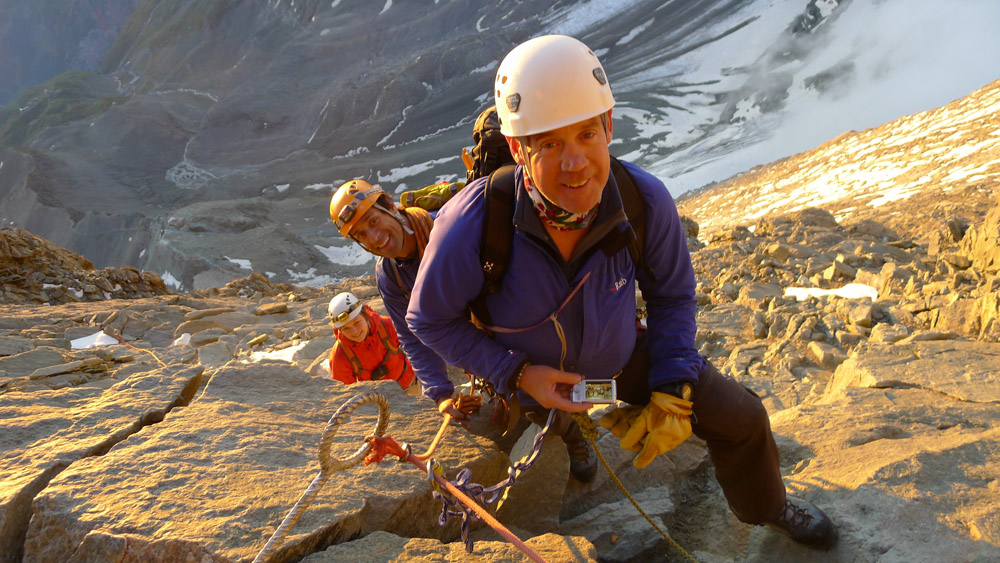
An unusually cheery queue at the bottom of the Lower Moseley Slab
Choosing a Guide
For many people the logical way of climbing the Matterhorn is with an IFMGA Mountain Guide. On a recent ascent, I was riding the lift up to Schwarzsee and a confident and articulate British tourist described how you simply didn’t need a Guide for the Matterhorn; it was, of course, far too “easy”. When pushed it became apparent that he had never set foot on the mountain, let alone possessed an understanding of the enormity of the task. So if the question ‘do I need a Guide for the Matterhorn?’ pops into your head, the answer is almost certainly ‘yes’.
In employing the services of a Guide you have a much better chance of success and completing the enterprise in a safe and timely manner. There is a good chance that it will also be much more enjoyable as well. If, instead, you are considering an ascent of the Matterhorn independently, then many of the other Valais peaks offer excellent routes on which to cut your teeth. Although nothing really compares to the Hörnligrat, traverses such as the South Ridge of the Laggingorn make ideal targets to practise movement on AD ground over a reasonable horizontal and vertical distance.
Many British Mountain Guides offer ascents on a private or course basis. The reality is that there is not much difference between the two, since the Matterhorn is guided at a 1:1 ratio. This local custom makes perfect sense for an ascent of such sustained commitment and technical difficulty, and has evolved to protect everybody on the mountain. In most cases an ascent would be made at the end of a six-day period, allowing acclimatisation time and some practice or warm-up ascents prior to a summit bid. Even for experienced alpinists with a good tick list behind them, it is important for both climbers (with a Guide or not) to be moving well together and have considerable trust in each other’s abilities. Moving together on a short rope often without protection between, is one of the true techniques of alpinism, demonstrating solidarity in the climbing partnership, mutual trust to move carefully and sure-footedly in pursuit of the summit.
Romanticisms aside, the techniques employed to climb the Matterhorn haven’t greatly changed since the first ascent in 1865, and Edward Whymper’s advice in his book ‘Scrambles Amongst the Alps’ is as true now as it was then: “Climb if you will, but remember that courage and strength are nought without prudence, and that a momentary negligence may destroy the happiness of a lifetime. Do nothing in haste; look well to each step; and from the beginning think what may be the end.”
My slightly bias advice for many people would be to hire a Guide, thus increasing your chances of success and ensuring you make the most of your previous training on any attempt. It is of course possible to hire a Swiss Guide purely for a summit attempt in Zermatt, but the approach is slightly different with the vast majority of hopefuls having a rather clinical test on a nearby summit. A different approach maybe, but with up to 150 attempting the Hörnligrat per day at the height of the season, the Swiss Guides Centre currently views this as essential.
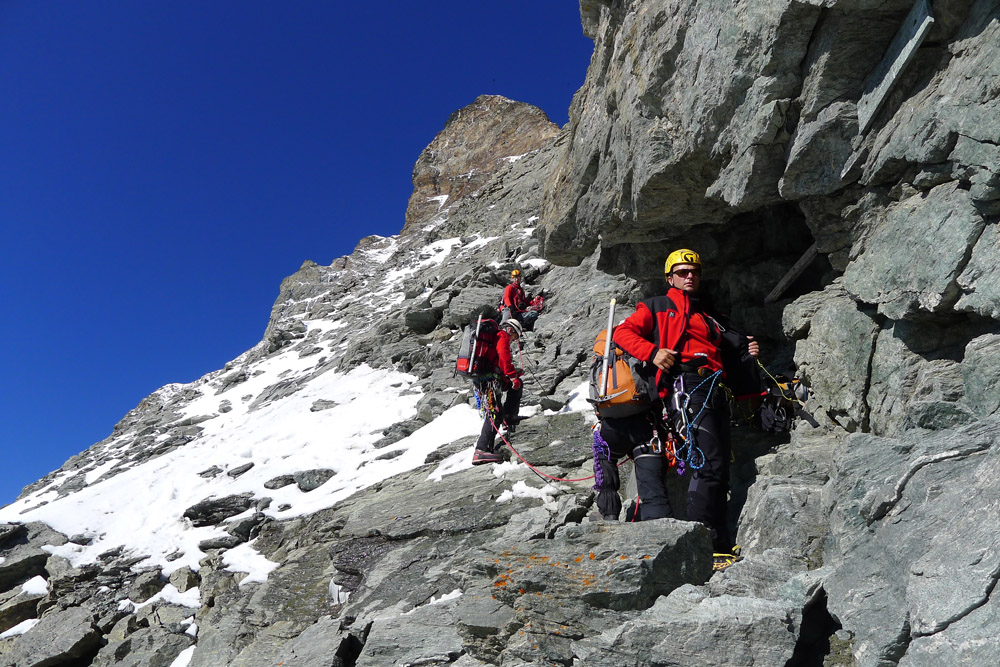
Climbers switching to crampons at the site of the ruined Solvay Hut in snowy conditions
Choosing kit
Having decided that the Matterhorn is firmly on your tick list it’s worth considering what equipment to take. This is one occasion where ‘light is right’ or, more correctly, ‘light is right because you are going to be carrying it up and down 1,200m’. Due to the huge vertical difference you need clothing to cope with a broad range of temperatures; most likely +30 degrees on the approach to the hut, followed by a pre-dawn start with temperatures just above freezing. This quickly gives way to warmer temperatures in the afternoon as you descend into the heat of the day. In most cases, a light pair of softshell trousers, thin thermal and softshell top will be the mainstay of any clothing system.
This can then be bumped up high on the mountain with a thin insulating layer. In addition, some lightweight waterproof trousers and a jacket will be useful in the bottom of your sac for an afternoon shower or windy conditions. I favour quite a light but stiff boot for the this sort of climbing, the stiffness allowing the effective use of small footholds as well as fitting a crampon. This is one area where I would always consider investing in a new pair of boots before other items; you will feel a heavy traditional mountaineering boot when you have been on a giant rock-based step machine for 1,200m!
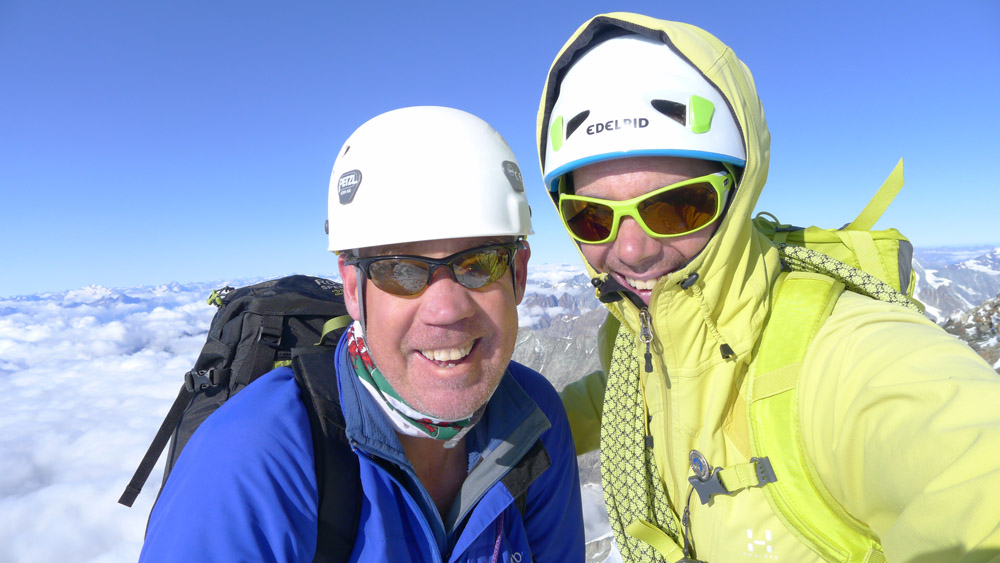
James Thacker and his client Tony Clapham on the summit in 2013
As I leave the hut I will already be wearing my harness and helmet as the route starts immediately with some fixed ropes. There are some small abseils or lowers on the way down so I prefer a harness with a little padding, shunning super-lightweight models. My rucksack should be small and light but with space for crampons, axe and additional layers as well as food and water. For the vast majority of the route, one person will probably have the rope in alpine coils around their body, as only a short distance is needed in ascent. To save a bit of weight I usually take a 40m rope, which is a good compromise between the added burden and usable length for abseils and lowers on key sections.
Finally, embrace the controlled chaos of one of the busiest summits in the Alps and enjoy a unique ascent from the Golden Era. Oh, and don’t forget that it’s not always good to join the back of the queue…
THE KNOWLEDGE: HORNLI RIDGE
WHEN TO GO: July and August are the only months sensible to try this route, as snow will still be lying before this. For weather conditions, check the webcam at www.zermatt.ch/en/Webcams/Berge-1/Untere-Riffelalp-2-111-m and weather forecast at www.zermatt.ch
HOW TO GET THERE: Fly to Zurich, and then either catch a train or drive to Zermatt or Breuil-Cervinia where you will be based.
HOW HARD: The Hörnli Ridge is graded AD, and you will ascend 1,220m from the Hörnlihutte. The guidebook time is 4-5 hours in ascent and 5-6 in descent. Although not too hard technically, excellent fitness is required as it is a very long day, plus a head for heights is helpful as the exposure in places is quite breathtaking. Plenty of previous alpine experience is recommended!
WHERE TO STAY: In the valley, stay in either Zermatt or Breuil-Cervinia. Walk up the night before to the Hörnlihutte – this is very busy though, so book well in advance. Hut Booking: Hörnlihutte www.hoernlihuette.ch/reservation_46.html, price is 150CHF per person with a discount for Alpine Club, CAF, SAC members.
WHAT TO TAKE: Waterproof jacket and pants, softshell pants, 25L backpack, belay jacket, lightweight mountaineering boots, 12-point crampons, ice axe, helmet, harness, 40m rope
WHO TO GO WITH: Unless you are a very experienced mountaineer, prospective Matterhorn climbers are advised to book an IFMGA Mountain Guide for their Hörnli Ridge climb. The author regularly guides on this route, see his website at www.jamesthacker-mountaineering.co.uk. Alternatively you can find other British Mountain Guides at www.bmg.org.uk

Feeling peaky?
BMC Travel insurance comes with £10 million emergency medical cover: Knock yourself out.
After Alpine & Ski insurance? We’ve got a great deal to keep you covered: 25% off all annual multi-trip policies in Europe, which works out at £141 for 12-months cover.
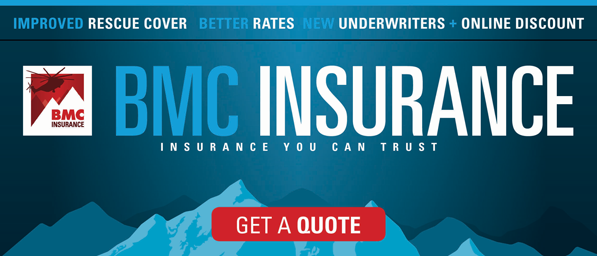
Years of experience
We’ve been insuring adventurers like you for over 30 years. That’s why all of our policies come with:
- 24-hour emergency assistance helpline
- £10 million emergency medical cover
- £100,000 search, rescue and recovery cover
- £10,000 personal accident cover
- £5,000 cancellation cover
- £2,500 baggage cover
- No age loading until you’re 70
WATCH: BMC Insurance: built for the mountains
Want to know more? READ: 5 reasons why you need BMC Travel Insurance
*Policy details: £141.80 for annual European Alpine and Ski cover up to age 69. For policies purchased between 14 May and 31 August 2018.


